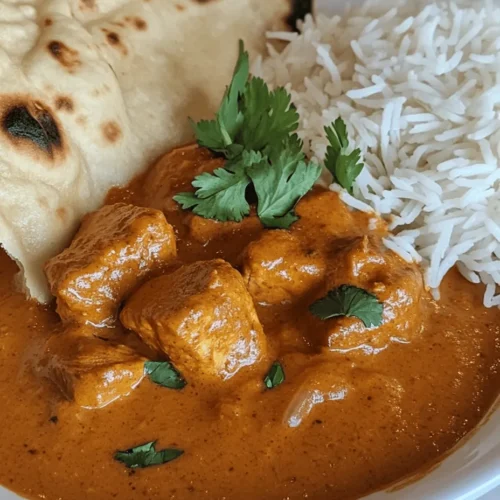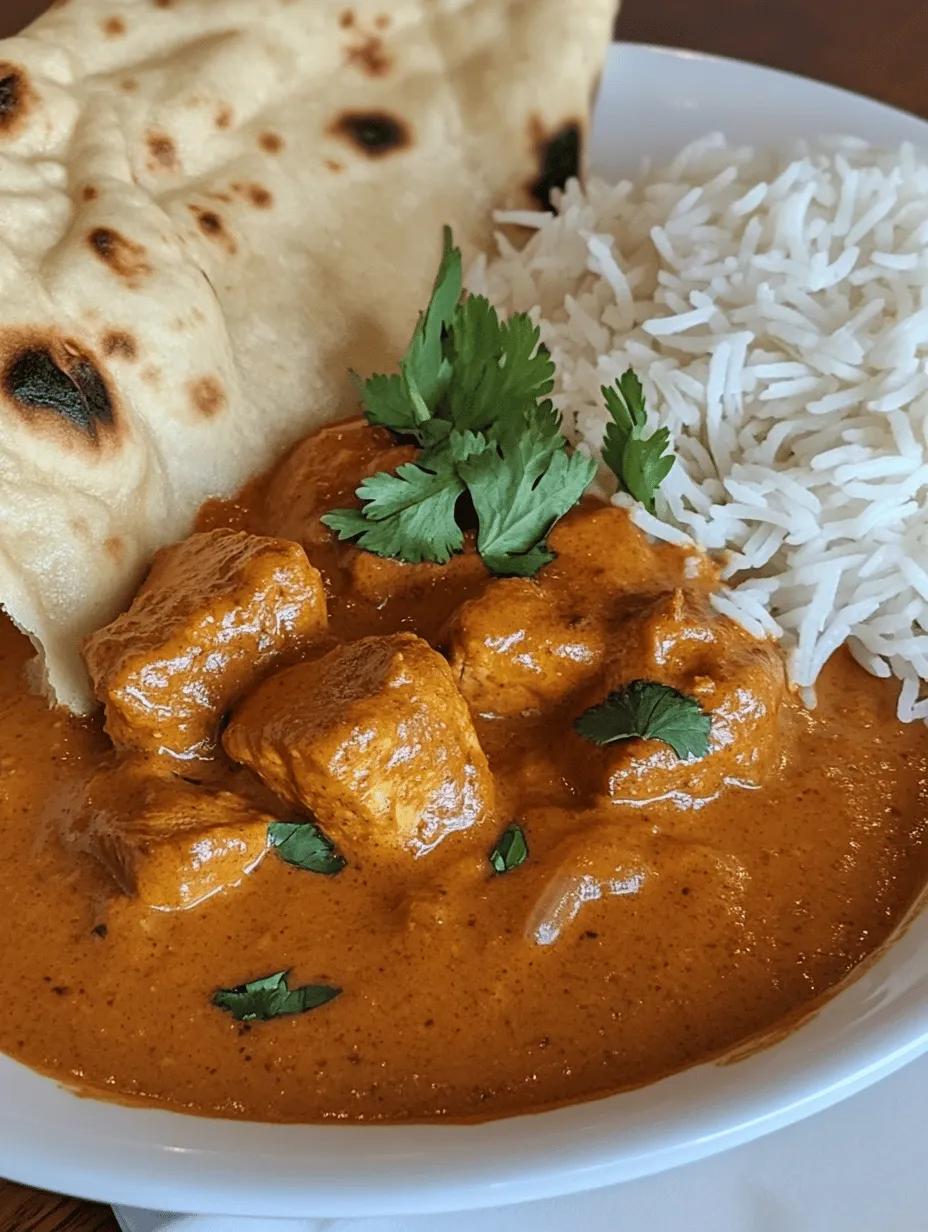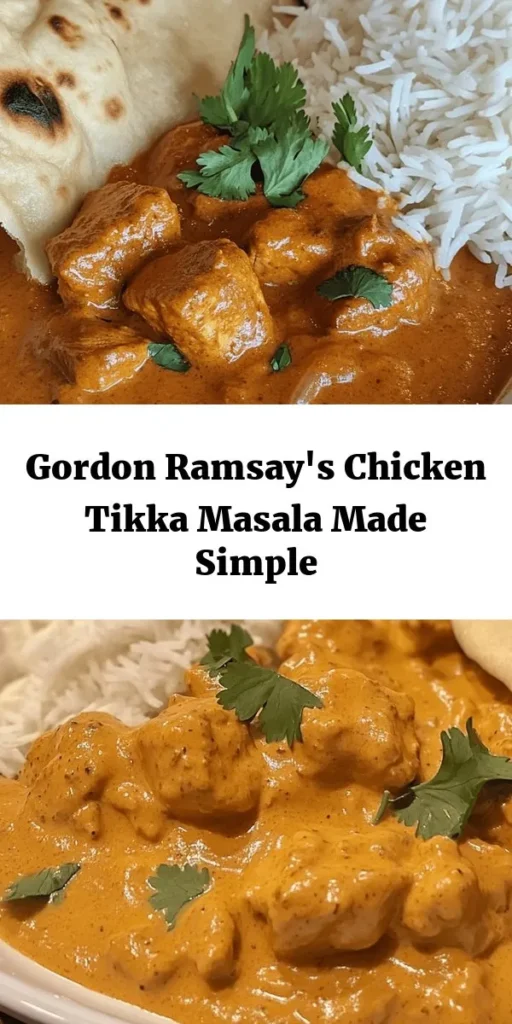Introduction
Chicken Tikka Masala is not just a dish; it represents a culinary legacy that has captivated taste buds across the globe. Originating from Indian cuisine, this vibrant dish combines marinated chicken pieces cooked in a rich, spiced tomato sauce. Its creamy consistency and aromatic flavor make it a beloved choice in many households and restaurants alike, often accompanied by fragrant basmati rice or warm naan bread. Within the realm of culinary expertise, Gordon Ramsay’s rendition of Chicken Tikka Masala stands out, celebrated for its meticulous attention to flavor and technique.
Gordon Ramsay, a chef known for his fiery personality and exceptional culinary skills, brings a unique twist to this classic dish. His version emphasizes a balance of flavors, combining traditional Indian spices with modern cooking techniques to create a Chicken Tikka Masala that is both authentic and innovative. Ramsay’s approach not only enhances the dish’s flavor profile but also showcases the importance of using fresh ingredients and authentic spices, which are crucial for achieving the best results. If you’re looking to impress family and friends or simply treat yourself to a comforting meal, following Ramsay’s recipe will undoubtedly elevate your cooking experience.
The Rich History of Chicken Tikka Masala
The origins of Chicken Tikka Masala are as rich and complex as its flavor. While the dish is often associated with Indian cuisine, there is considerable debate about its true origins. Some culinary historians suggest that Chicken Tikka Masala was created in the United Kingdom, emerging as a fusion of Indian and British culinary traditions. The story goes that the dish was developed in the 1960s when a British chef, faced with a customer who wanted a milder sauce, combined leftover chicken tikka with a creamy tomato sauce. This innovation paved the way for what would become one of the most popular curries in the UK.
As immigration from India to Britain increased in the latter half of the 20th century, so did the appreciation for Indian cuisine. Restaurants that served authentic Indian dishes began to pop up, and Chicken Tikka Masala quickly became a staple menu item. Its rise to prominence was further solidified when it was named “Britain’s national dish” by former Foreign Secretary Robin Cook in 2001, highlighting its cultural significance and popularity.
The evolution of Chicken Tikka Masala is a testament to the blending of cultures and flavors. With each generation, chefs have adapted the recipe, incorporating local ingredients and personal touches, making it a dish that resonates with diverse communities. Today, Chicken Tikka Masala is a beloved comfort food known for its versatility and ability to bring people together, whether it’s enjoyed in a fine dining restaurant or a cozy home kitchen.
Understanding the Key Ingredients
To recreate Gordon Ramsay’s Chicken Tikka Masala successfully, understanding the key ingredients is essential. Each component plays a vital role in building the dish’s rich flavor and creamy texture.
Chicken Breast
The primary ingredient in Chicken Tikka Masala is, of course, chicken breast. Choosing quality meat is crucial for achieving the best results. Opting for organic or free-range chicken breast not only ensures better flavor but also contributes to the overall quality of the dish. Tender and juicy chicken pieces, marinated effectively, serve as the foundation for the dish. The marination process allows the chicken to absorb the spices and yogurt, resulting in a more flavorful and succulent final product.
Yogurt
Yogurt is another essential ingredient in this dish. It serves two important purposes: marination and flavor enhancement. The acidity of yogurt helps tenderize the chicken, making it more succulent, while also infusing it with flavor. The marination process typically involves mixing yogurt with spices, creating a rich paste that clings to the chicken. This not only infuses the meat with flavor but also helps retain moisture during cooking, resulting in perfectly cooked chicken.
Spices
The heart of Chicken Tikka Masala lies in its spices. A combination of garam masala, cumin, coriander, turmeric, and chili powder creates a complex flavor profile that is both aromatic and vibrant.
– Garam Masala: This spice blend typically includes a variety of spices, such as cinnamon, cardamom, and cloves. It is essential for adding warmth and depth to the dish.
– Cumin: Cumin has a nutty, earthy flavor that complements the other spices and adds a hint of smokiness.
– Coriander: Ground coriander contributes a citrusy, floral note that brightens the dish.
– Turmeric: Known for its stunning golden color, turmeric adds a mild, earthy flavor and is also celebrated for its anti-inflammatory properties.
– Chili Powder: Depending on the variety used, chili powder can add heat and depth, ensuring a balanced flavor without overpowering the dish.
Incorporating these spices not only enhances the flavor but also offers health benefits, making Chicken Tikka Masala a delicious and nutritious option.
Coconut Milk vs. Heavy Cream
When it comes to the creamy element of Chicken Tikka Masala, chefs often debate between using coconut milk or heavy cream. Both options have distinct characteristics that can affect the final dish.
– Coconut Milk: This ingredient is lighter and adds a subtle sweetness to the sauce. It is a fantastic option for those looking for a dairy-free alternative and can impart a unique flavor that complements the spices.
– Heavy Cream: On the other hand, heavy cream offers a rich, velvety texture that creates a luxurious sauce. It enhances the dish’s creaminess and balances the spices, resulting in a more traditional preparation.
The choice between coconut milk and heavy cream ultimately depends on personal preference and dietary restrictions. Both options can yield delicious results.
Fresh Herbs
Lastly, fresh herbs, particularly cilantro (or coriander), play a crucial role in garnishing Chicken Tikka Masala. The vibrant green leaves add a burst of freshness that contrasts beautifully with the rich, spiced sauce. Not only do they enhance the dish’s presentation, but they also contribute a layer of flavor that brightens each bite. Using fresh herbs instead of dried is key to elevating the dish and ensuring it has a vibrant, appealing finish.
Step-by-Step Guide to Preparing Gordon Ramsay’s Chicken Tikka Masala
Now that you have a thorough understanding of the ingredients, it’s time to dive into the preparation process of Gordon Ramsay’s Chicken Tikka Masala. This recipe emphasizes the importance of preparation, ensuring that each step is followed to achieve the best possible results.
Step 1: Marinate the Chicken
Begin by cutting the chicken breast into bite-sized pieces. In a large bowl, combine yogurt with a mix of spices, including garam masala, cumin, coriander, turmeric, and chili powder. This mixture should be thick enough to coat the chicken evenly. Add a pinch of salt and a squeeze of lemon juice to the marinade for added flavor. Place the chicken pieces into the bowl, ensuring they are well coated. Cover the bowl with plastic wrap and let it marinate for at least 1 hour, or preferably overnight in the refrigerator. The longer you marinate, the more flavor the chicken will absorb.
Step 2: Cook the Chicken
Once the chicken has marinated, it’s time to cook it. Preheat your grill or a grill pan over medium-high heat. For the best results, the grill should be hot enough to sear the chicken quickly, locking in the juices and flavor. Thread the marinated chicken onto skewers, leaving a bit of space between each piece to ensure even cooking. Grill the chicken for approximately 10-15 minutes, turning occasionally until the chicken is cooked through and has nice char marks. Alternatively, you can bake the skewers in a preheated oven at 200°C (400°F) for a similar result.
Step 3: Prepare the Sauce
While the chicken is cooking, it’s time to prepare the sauce. In a large skillet or saucepan, heat a tablespoon of oil over medium heat. Add finely chopped onions and sauté until they become translucent. This step is vital, as it forms the aromatic base of the sauce. Once the onions are soft, add minced garlic and ginger, cooking for an additional minute until fragrant.
Next, add the remaining spices (garam masala, cumin, coriander, turmeric, and chili powder) to the pan, stirring them through the onion mixture. This technique, known as blooming the spices, releases their essential oils and enhances their flavors. After a minute, pour in crushed tomatoes and bring the mixture to a simmer. Allow the sauce to cook for about 10 minutes, stirring occasionally until it thickens slightly.
Step 4: Combine Chicken and Sauce
Once the chicken is cooked, remove it from the grill and let it rest for a few minutes. Cut the chicken into smaller pieces if desired, then add it to the simmering sauce. Stir well to combine, ensuring that every piece of chicken is coated in the rich sauce. If you prefer a creamier sauce, this is the time to add either heavy cream or coconut milk to the mixture. Allow the chicken to simmer in the sauce for another 5-10 minutes, letting the flavors meld together beautifully.
Step 5: Garnish and Serve
After the chicken has simmered in the sauce, remove it from heat. Before serving, garnish with freshly chopped cilantro for an added pop of color and flavor. Serve the Chicken Tikka Masala with warm naan, basmati rice, or your favorite side dish, allowing everyone to enjoy this delightful classic.
With these steps, you can recreate Gordon Ramsay’s Chicken Tikka Masala in your kitchen, bringing the flavors of India with a touch of modern culinary flair to your dining table. This dish is not only a feast for the senses, but it also reflects the rich tapestry of cultural influences that have shaped its evolution over time.

Marinating the Chicken
Marination is a vital step in ensuring that your Chicken Tikka Masala is bursting with flavor. The primary purpose of marinating chicken is to infuse it with spices and tenderness, allowing its juices to permeate the meat. For Gordon Ramsay’s Chicken Tikka Masala, you should aim for a marination time of at least 2 hours, but ideally, overnight is best. This allows the yogurt and spices to deeply penetrate the chicken, resulting in moist and flavorful pieces.
To marinate, combine plain yogurt with spices such as garam masala, cumin, coriander, turmeric, and chili powder. This mixture not only enhances the flavor but also helps tenderize the meat. The acidity in yogurt breaks down the proteins in chicken, making it juicy and tender. After marinating, ensure you let the chicken sit at room temperature for about 30 minutes before cooking. This helps in achieving an even cook and prevents the chicken from being shocked by high heat.
Cooking the Chicken
Once your chicken has marinated, it’s time to cook it to perfection. Begin by preheating your grill or skillet over medium-high heat. For a traditional approach, using a grill will give your chicken a smoky flavor, while a skillet can yield a nice sear. Make sure to oil the grill or skillet lightly to prevent sticking.
To achieve the perfect sear, add the chicken pieces in batches, ensuring not to overcrowd the pan. Overcrowding can cause the chicken to steam instead of sear, compromising that desired caramelized exterior. Cook each side for about 4-5 minutes or until golden brown and cooked through. The internal temperature should reach 165°F (75°C).
After cooking, let the chicken rest for a few minutes before cutting it. This resting period allows the juices to redistribute, ensuring each bite remains succulent and flavorful.
Crafting the Sauce
While the chicken is resting, turn your attention to the sauce. Begin by heating oil and a tablespoon of butter in a large saucepan over medium heat. Add finely diced onions and sauté them until they become soft and translucent, about 5-7 minutes. This step is crucial as it forms the base of your sauce, creating a rich flavor profile.
Next, incorporate minced garlic and ginger, cooking them for an additional minute until fragrant. Follow this by adding spices such as garam masala, cumin, and coriander, allowing them to toast slightly in the heat. This will release their essential oils and intensify the flavors.
Once the spice mixture is aromatic, pour in crushed tomatoes and allow the sauce to simmer for about 15 minutes. This simmering process deepens the flavors, allowing the tomatoes to meld with the spices. Stir in cream towards the end of the cooking process to create a rich and luscious sauce that envelops the chicken pieces beautifully.
Combining Ingredients
With both the chicken cooked and sauce ready, it’s time to bring everything together. Start by adding the seared chicken pieces to the simmering sauce. Ensure each piece is well-coated, allowing the chicken to absorb the sauce’s flavors. Let it simmer together for an additional 5-10 minutes on low heat. This not only warms the chicken through but also allows the flavors to meld.
Taste and adjust seasonings, adding salt, pepper, or more chili powder as needed. Remember that the balance of flavors is key in Indian cuisine, so don’t hesitate to fine-tune according to your preference.
Final Touches
The last step is all about presentation and final adjustments. Before serving, sprinkle fresh cilantro on top for a burst of freshness and color. This not only enhances the visual appeal but also adds a layer of flavor that complements the dish beautifully.
When plating, consider serving the Chicken Tikka Masala in a shallow bowl, allowing the vibrant colors of the sauce and chicken to shine through. You can also drizzle a bit of cream on top for an elegant finish.
Pairing Suggestions for Chicken Tikka Masala
To elevate your Chicken Tikka Masala experience, consider these pairing suggestions:
Complementary Side Dishes
– Basmati Rice: Basmati rice is the quintessential accompaniment to Chicken Tikka Masala. Its long grains and fluffy texture soak up the rich sauce, making it a perfect side. The subtle nuttiness of basmati rice complements the spiced chicken without overpowering it.
– Naan Bread: Different types of naan bread can enhance your meal significantly. From classic plain naan to garlic naan or even butter naan, these soft, pillowy breads are perfect for scooping up the chicken and sauce, providing a delightful contrast in texture. Naan not only serves as a utensil but also adds a layer of flavor to your meal.
Beverage Pairings
To further enhance your dining experience, consider pairing your Chicken Tikka Masala with beverages that complement its spices. A chilled glass of mango lassi provides a sweet and creamy contrast to the heat of the dish. Alternatively, a crisp Indian lager or a spiced chai tea can also be excellent choices, balancing the richness of the curry.
Nutritional Insights
When enjoying Chicken Tikka Masala, it’s essential to consider its nutritional value. Typically, this dish is rich in protein due to the chicken and can provide a good amount of healthy fats from the yogurt and cream. However, it can also be calorie-dense, so portion control is key.
Balancing Indulgence with Healthy Eating
To enjoy this dish while keeping your dietary goals in check, consider the following suggestions:
– Use lean chicken: Opt for skinless chicken breast or thighs to reduce fat content.
– Reduce cream: You can substitute heavy cream with coconut milk or low-fat yogurt to lighten the sauce without sacrificing flavor.
– Increase vegetables: Adding vegetables like bell peppers, spinach, or peas to the sauce can enhance the nutritional profile while adding color and texture.
Modifications for Dietary Restrictions
If you’re catering to specific dietary needs, adapting the recipe is straightforward:
– Gluten-Free: Ensure that your naan is gluten-free or serve with rice instead.
– Dairy-Free: Substitute yogurt and cream with coconut milk or cashew cream, which will still provide richness without the dairy.
Conclusion
Chicken Tikka Masala holds a special place in both traditional and contemporary cuisine, celebrated for its rich flavors and comforting qualities. This dish not only warms the heart but also brings people together, making it a perfect choice for family dinners or gatherings with friends.
By following this recipe, you will not only create an authentic Chicken Tikka Masala but also develop your culinary skills and confidence in the kitchen. The joy of cooking is not just in preparing a meal but in sharing it with loved ones, fostering connections over delicious food.
So, gather your ingredients, embrace the cooking process, and enjoy the rewarding experience of making this flavorful classic at home. Happy cooking!



